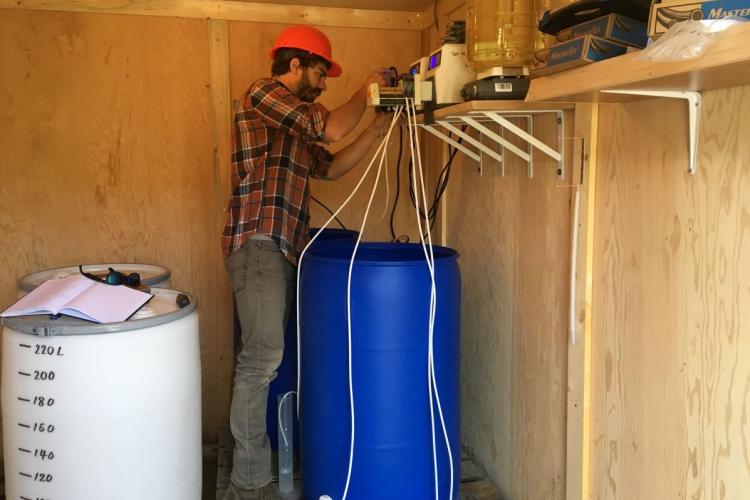Breadcrumbs
Innovative solutions for northern mine water treatment

Passive water treatment technologies can support Yukon’s mining industry effectively manage mine-impacted water. To work well in the Yukon, these technologies must be cost effective, low maintenance to endure harsh weather conditions.
Industrial Research Chair in Northern Mine Remediation (NMR) at Yukon University, Dr. Guillaume Nielsen, set up four pilot-scale bioreactors at Eagle Gold Mine—located on the Traditional Territory of the First Nation of Na-Cho Nyäk Dun—in 2019 and monitored them for three years.
Each bioreactor contained locally sourced bacteria exposed to freezing and thawing to see if they could survive subarctic conditions while effectively removing metal(loids) selenium and antimony from mine impacted water. Two bioreactors were placed in a heated shed during the winter, and the others were left outside to freeze.
“Using native bacteria from subarctic regions is really important because they’re already cold adapted and can service in Yukon environments,” says Dr. Nielsen. “However, making them work for us is a different challenge, and we must provide an appropriate environment—bioreactors plus food—for them to work. In real conditions, these bioreactors may freeze during winter, and we wanted to understand how freeze and thaw cycles impact bacterial populations.”
The genomic characterization showed that microbial populations quickly recovered from freeze-thaw cycles and remained consistent after the spring thaw in the outside bioreactors. These results show that bioreactors containing locally sourced bacteria were primarily unaffected by freezing and thawing, proving their strength in extreme climatic conditions.
“This means that if we develop passive water treatments relying on bacteria, when mine impacted water freezes on site, the bioreactors do not need to be taken care of, such as being heated or being fed with carbon sources,” says Dr. Nielsen. “This is a huge finding as winter maintenance on bioreactors could be very costly and would not make the technology ‘passive’ anymore.”
Over the duration of the project, six YukonU students were hired as research assistants. They participated in the implementation of the bioreactors, sampling events, monitoring, analysis in the YukonU research lab and report writing.
The results from Dr. Nielsen’s research were published in Springer Nature's Mine Water and the Environment journal—alongside contributors Morgane Desmau (lead author), Rachel Simister and Susan A. Baldwin. Peer reviewed papers are shared in worldwide databases, which puts NMR and YukonU on the map.
Genomic characterization and DNA extraction for the project was completed at the University of British Columbia. Funding partners include Natural Sciences and Engineering Research Council of Canada and Yukon Mining Research Consortium.
Link: https://rdcu.be/dSTWa